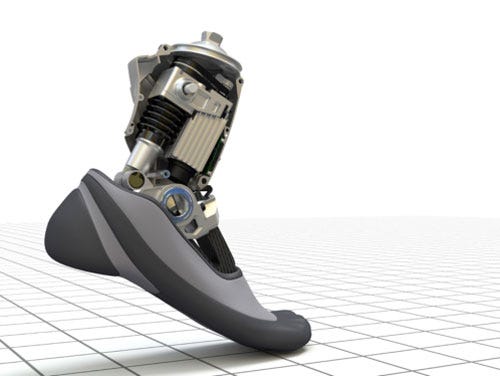February 5, 2014
|
(courtesy BiOM) |
Looking like they could have been assembled from spare parts for the latest RoboCop, the most advanced lower-leg prosthetics available today are arguably made by BiOM (Bedford, MA). The company's powered artificial ankle is unlike any other commercially available ankle device. The BiOM Ankle System replaces the function of lost muscle and tendon anatomy, stiffening and powering the prosthetic ankle. The idea is to duplicate, as closely as possible, what the muscles do in a natural leg.
The BiOM is the brainchild of MIT professor Hugh Herr, PhD, who lost his lower limbs to frostbite in a mountain climbing accident in 1982. Frustrated with the passive prosthetics on the market, Hugh developed prototypes for the devices out of wood and metal that eventually enabled him to climb mountains better than he could with his natural limbs. Herr has continuously improved the designs over the past three decades, making them motorized and flexible, and thus capable of simulating the form and function of natural muscle tissue and bone.
Learn about cutting-edge medtech technologies and trends at MD&M West, which is held February 10-13 in Anaheim, CA. |
The device is an example of how microprocessor and sensor advances are enabling advances in prosthetics.
The BiOM is embedded with sensors, which relay information to a computer that determines the user's intention to stand, walk, or run as well as the surrounding environment. The device can emulate the spinal cord's communication with the limbs. "A lot of bionics is stealing from nature," Herr quipped in a recent talk captured by Business Insider. Now that the technology has been shown to emulate human mobility, Herr believes the next stage is to use prosthetics to extend what humans are capable of and develop prosthetics that can interface directly with the nervous system.
Time magazine has termed Herr the "Leader of the Bionic Age." In 2012, UBM Canon's own MD+DI magazine honored the BiOM Ankle Prosthetic Device with a Silver award at the Medical Design Excellence Awards. Popular Mechanics magazine was so impressed they honored Herr, the device's inventor and BiOM's chief technical officer, with their first annual Breakthrough Leadership Award for his work in developing next-generation prosthetic devices. Herr is head of MIT Media Lab's Biomechatronics Group and NEC career development Professor.
Herr's BiOM Ankle System is powered by a battery that currently holds sufficient charge to power about 4000 steps. This Bionic Propulsion, as Herr calls it, is a unique ankle technology that actually mimics the action of the Achilles tendon and other muscles, powering movement and producing a more natural gait. The company's website says no other commercially-available ankle device provides this propulsion during the walking phase when the foot is in contact with, then pushing off from, the ground.
This propulsion energizes a person's gait. The onboard microprocessors provide programmable ankle stiffness modulation and variable power assist. By replacing lost muscle function, Bionic Propulsion improves the wearer's mobility and provides additional stamina to walk greater distances...faster. It's designed to make the wearer feel safer and more stable on stairs, ramps, and uneven terrain.
The BiOM prosthesis has 2 microprocessors and 12 sensors that allow walking and even running with a natural gait. The artificial intelligence in the software interprets the sensor data to keep the user automatically balanced and moving. The microprocessors and sensors allow natural movement, but users get no sensory feedback at this stage of development. Current research at the MIT Media Lab could change this, as they are working on connecting the device to nerve tissue to restore some degree of feeling to the wearer.
Matt Albuquerque, president of Next Step Bionics & Prosthetics, which sells the ankle, told Jason Schwartz in an article for Boston magazine, "We've had some people say to us it's the closest thing they've had to having their leg back. That had been something I've never heard before."
However, Schwartz points out one problem. "At about $50,000, it costs up to $40,000 more than a standard prosthesis, and isn't covered by Medicare, Medicaid, or most insurers. That means most amputees can't afford it." BiOM has sold about 1000 units since it launched the product in 2011, Schwartz reported in December 2013, and most of its customers have been veterans, covered by the Department of Defense or the Veterans Administration.
BiOM was founded in 2006 by Herr. Originally named iWalk, the company has received funding and support from the U.S. Department of Veterans Affairs, the U.S. Army's Telemedicine and Advanced Technology Research Center (TATRC) and leading investment firms.
About the Author(s)
You May Also Like



